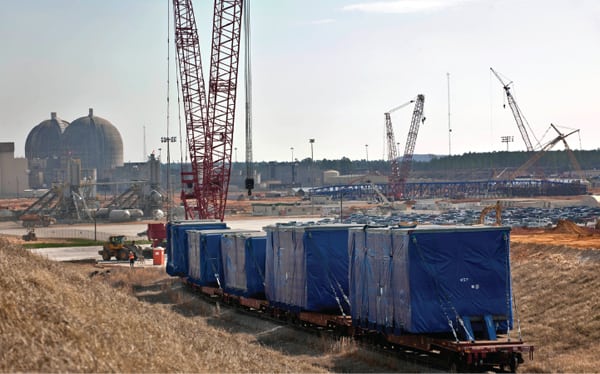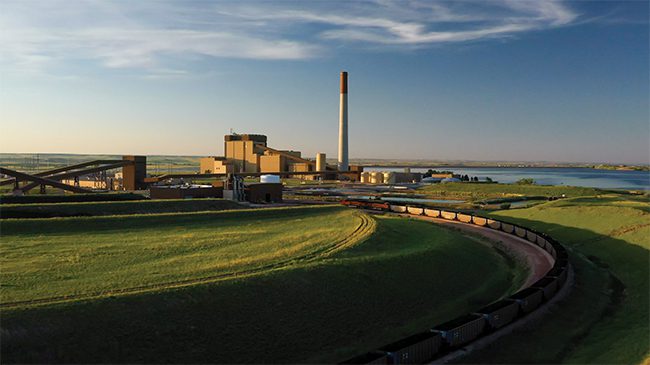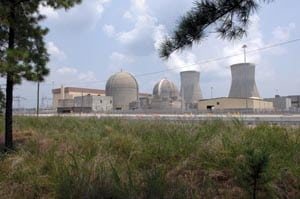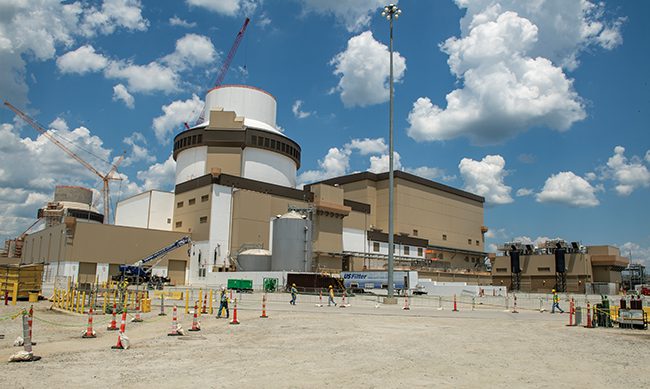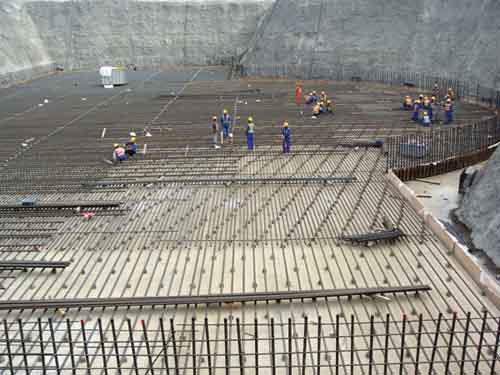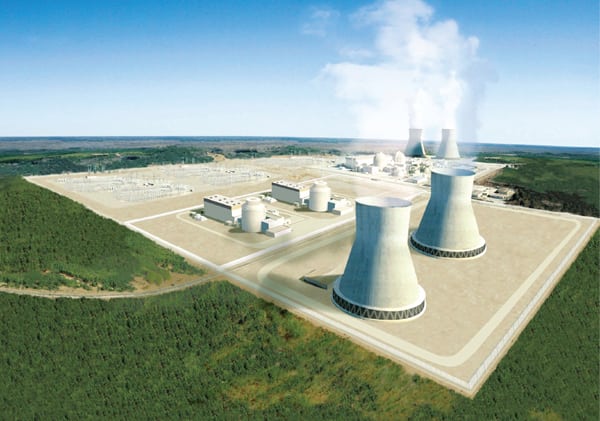
Courtesy: Southern Company Inc.
In February 2012, the Nuclear Regulatory Commission approved two combined construction and operating licenses for Southern Nuclear’s Plant Vogtle Units 3 and 4 in Georgia. They were the first licenses ever approved for a U.S. nuclear plant using the one-step licensing process and the first allowing construction in more than three decades. Now the real work begins.
The Nuclear Regulatory Commission (NRC) voted 4-1 to approve two combined construction and operating licenses (COLs) for Southern Nuclear’s Alvin W. Vogtle Electric Generation Plant (Plant Vogtle) Units 3 and 4 on February 9. Receipt of the COLs concluded a regulatory process lasting almost four years and officially authorizes Southern Nuclear to build and operate two 1,100-MW Westinghouse AP1000 pressurized water reactors (PWRs) at the Georgia plant. Unit 3 is expected to begin operating in 2016 and Unit 4 in 2017. (See sidebar “What Is NuStart?”)
Plant Vogtle is one of Georgia Power’s two nuclear facilities and one of three nuclear facilities in the Southern Co. system. Southern Nuclear, a subsidiary of Southern Co. since 1990, is the licensed operator of Plant Vogtle, which is located about 25 miles south of Augusta, Ga. The plant is jointly owned by Georgia Power (45.7%), Oglethorpe Power Corp. (30%), Municipal Electric Authority of Georgia (22.7%), and the Dalton Utilities (1.6%).
Units 1 and 2 consist of Westinghouse four-loop PWRs rated at 1,109 and 1,127 MW respectively, and are shown at the top of the artist rendering above. Unit 1 began commercial operation in 1987; Unit 2 followed in 1989. The two new Generation III+ nuclear reactors that are expected to enter commercial service in 2016 and 2017 are shown in the foreground.
POWER first visited Southern Nuclear’s Vogtle Units 3 and 4 site in Waynesboro, Ga., to report on construction progress of the two nuclear plants in late 2009 (see “Plant Vogtle Leads the Next Nuclear Generation” in the November 2009 issue or in the archives at https://www.powermag.com). At the close of that article, we said, ”We expect Plant Vogtle to be the first of the next generation of nuclear plants to enter commercial service during 2016.” Southern Nuclear is on track to prove our prediction correct.
Just prior to that 2009 visit, the NRC had issued an early site permit (ESP) and limited work authorization (LWA) approvals to begin site clearing and safety-related excavation activities in anticipation of the NRC issuing a COL for each of the two new reactors.
The COL is a one-step licensing process that was designed to reduce NRC regulatory red tape by simultaneously issuing a license to construct and to operate a new nuclear plant; it replaced the delay-prone two-step process used in the 1970s and 80s (see “Second Set of COLs Approved”). In the past, it was common for licensing requirements to change in the middle of construction, resulting in costly redesigns and delays, thus dramatically escalating construction costs. NRC records indicate that the last construction permit issued using the old two-step process was in 1978 for the Shearon Harris 1 nuclear plant in North Carolina
In addition to the one-step COL process, companies are selecting preapproved NRC standardized reactor designs, such as the Westinghouse AP1000 PWR, that incorporate vendor-designed skids, equipment packages, and modular construction techniques that are expected to prevent the rampant construction cost escalation experienced in the past. The AP1000 is a modular design that uses passive safety systems that rely on gravity, natural circulation, and convection to maintain safe operation and to shut the plant down safely during an off-normal event. These features increase reliability and reduce maintenance and operating costs.
Got COLs. What’s Next?
With the COLs in hand, Southern Nuclear is fully authorized to construct and operate two 1,100-MW Westinghouse AP1000 PWRs at the Vogtle site, adjacent to the company’s existing Units 1 and 2. Westinghouse has partnered with Shaw to provide engineering, procurement, and construction services (see “Construction Is a Cooperative, Global Effort”).
POWER recently visited with Cheri Collins, general manager and nuclear liaison for Vogtle Units 3 and 4, for an update on the work completed since our visit in late 2009. Collins noted that most of the work over the past two years has been in subsurface soil preparation: “The LWA allowed for the excavation and selection of soil that met the appropriate strength and stability criteria to be used as backfill, and the compacting of that soil for the foundation for the nuclear island and reactor. It was important for this nuclear grade soil to be free of clay to meet these criteria.” That work has been completed.
“The next series of milestones could not have occurred until the COL was received—the pouring of safety-related concrete. The next series of steps consists of pouring a 6-foot-thick reinforced concrete base mat that will be underneath the containment vessel. Following the pouring of the concrete base mat, we will place a concave basket made out of rebar that is being fabricated as the pouring is taking place. The containment vessel bottom head will be placed inside this concave rebar basket, and more concrete will be poured around it to secure the containment vessel bottom head in place.”
Figures 1 and 2 illustrate construction work in progress.
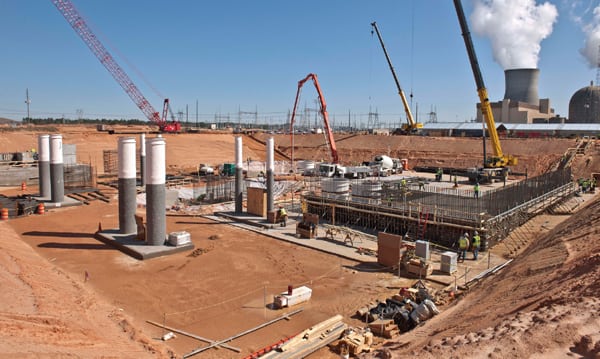 |
| 1. From the ground up. Construction of Vogtle Unit 3 turbine building foundation basement is under way. Photo was taken on March 5, 2012. Courtesy: Southern Company Inc. |
 |
| 2. Modular assembly. Welding of the Vogtle Unit 3 containment vessel bottom head assembly is under way. Photo was taken on January 30, 2012. Courtesy: Southern Company Inc. |
Looking to the future, Collins emphasized that even with the COLs in hand, a few significant milestones must be achieved before the NRC will authorize Vogtle to load fuel into the reactor. “We have the COL, permission to build plant, but the NRC will not allow us to load fuel until we have enough licensed operators that have passed all the tests and are ready to run the plant. Also, we must successfully pass all the inspections, tests, and analyses that are a part of verifying that this plant was built according to design,” Collins added. “There is an entire group of people focused on well over 800 inspections, tests, analyses, and acceptance criteria (ITAAC) work packages for both units. When the ITAAC packages are satisfactorily completed and the NRC has reviewed and approved these packages, then they will allow us to load fuel.”
Receipt of the COL is also an important milestone for financing of the projects. On June 18, 2010, Southern Co., on behalf of Georgia Power, accepted the first conditional commitment for federal nuclear loan guarantees of approximately $3.4 billion, or 70% of Vogtle Units 3 and 4 eligible project costs. The loan from the Federal Financing Bank includes a first lien to the Department of Energy (DOE) for Georgia Power’s ownership in Vogtle Units 3 and 4 secured by Georgia Power’s 45.7% interest in the two new units and was contingent upon receipt of the COL from the NRC. The entire project is estimated to cost about $14 billion. Georgia Power’s share of the construction cost is currently forecast to be about $6.1 billion, including $1.7 billion of financing costs to be collected during construction.
The loan for Units 3 and 4 was authorized by Section 1703 of the 2005 Energy Policy Act’s Title XVII, which allows financing of clean energy technologies (including nuclear, advanced fossil energy coal, carbon sequestration, and projects promoting industrial energy efficiency) that are unable to obtain conventional private financing due to high technology risks. Collins reminded us that “Southern Company is on record that we do not need the loan guarantee to build the plant. It allows us to get capital at a lower interest rate. This reduces financing costs, and those savings are passed directly to our customers. The savings translate back to customer at about $25 million a year for the 30-year life of the bond.”
NRC Involvement Continues
On March 11, 2011, the Great East Japan Earthquake—rated a magnitude 9.0—and subsequent tsunami decimated the Fukushima Daiichi nuclear plant site and produced widespread devastation across northeastern Japan. (“Nuclear Power in the Shadow of Fukushima,” July 2011 and “The Fukushima Fallout: Six Months After the Nuclear Crisis,” September 2011 are examples of the extensive coverage of the accident available in the POWER archives at https://www.powermag.com.) That event clearly affected the NRC’s vote on the first COLs.
Four NRC commissioners (Kristine L. Svinicki; George Apostolakis; William D. Magwood, IV; and William C. Ostendorff) voted to grant the COLs, while Chairman Gregory Jaczko cast the only dissenting vote. According to the Augusta Chronicle, Jaczko said he could not support issuing the license as if Fukushima had not happened.
The commissioners agreed in spirit with Jaczko that the NRC’s responsibility is to make the best decisions for nuclear safety. There opinions divide.
“There is no amnesia, individually or collectively,” Commissioner Svinicki said of the NRC’s attention to lessons learned from Fukushima. Commissioner Magwood agreed. “Plant Vogtle’s units 3 and 4 will represent a new era of nuclear safety,” he said.
The four commissioners recognized that Jaczko’s proposed COL conditions would necessarily lack sufficient details to impose meaningful design requirements and would be largely symbolic. The commissioners agreed that there was no compelling reason to depart from the NRC’s existing regulatory processes and expressed confidence that safety recommendations made since the Japan crisis will be properly implemented. Svinicki added that NRC staff did not recommend nor support Jaczko’s idea of an across-the-board license condition requiring implementation of “all” Fukushima-related requirements prior to operation of the Vogtle nuclear plant, given the myriad regulatory tools available to the NRC to implement post-Fukushima-related requirements as they emerge, including those applicable to new plants like Vogtle.
Whereas the NRC’s Operating Reactor Oversight program focuses on monitoring and evaluating the performance of existing nuclear power plants, regulatory oversight for new reactors is controlled by the Construction Reactor Oversight Process (cROP) that focuses on the construction period between licensing and initial operation of new reactors.
In the cROP, the staff determines the scope and then implements the construction inspection program (CIP) that consists of four phases. The first and second phases support a licensing decision for an ESP and COL application. Inspections will initially be conducted to verify effective implementation of the quality assurance program, as described in the application for an ESP and/or COL, to provide reasonable assurance of the integrity and reliability of the application data or analyses that would affect the performance of safety-related systems, structures, and components (SSCs). The third and fourth phases support construction activities and preparations for operation.
Prior to and during plant construction, inspections will be conducted to review vendor activities and licensee oversight of these activities. During plant construction, inspections will be conducted to verify satisfactory completion of the ITAAC, confirm adequate development and implementation of construction and operational programs, and review the transition to power operations.
The core of the CIP is carried out by construction resident on-site inspectors (CRIs) assigned to the site by the Region II Center for Construction Inspection (CCI). At least two inspectors are assigned to each site once significant construction activities are under way. The CRIs will be supplemented with additional personnel from CCI, other regional offices, and headquarters technical staff, as needed, to provide reasonable assurance that the as-built facility conforms to the conditions of the COL.
Safety Measures
In October 2011 the NRC directed staff to begin implementing seven safety recommendations from the Near-Term Task Force on lessons learned from the Japanese event. The recommendations affecting all U.S. nuclear reactors are expected to be completed by April 2014. The seven recommendations, in general, cover loss of all AC power at a reactor that could prompt a “station blackout”; seismic and flooding hazards; protection for equipment from design-basis external events; emergency equipment and severe accident management guidelines; and training.
In addition to these new NRC requirements derived from lessons learned from Fukushima, U.S. nuclear plants are designed to withstand seismic events, high winds—including flying debris produced by tornadoes, and flooding. The following information describes how the AP1000 plant would react when faced with each of these severe accident conditions.
Seismic Events. As with every U.S. nuclear power plant, all of Southern Co.’s existing plants were designed, licensed, and constructed to withstand a maximum credible earthquake for their site location based on historical seismic activity and tectonic and geological data for that location, as will be Units 3 and 4.
Plant Vogtle Units 1 through 4 are equipped with seismic monitoring systems that are set at extremely low triggering levels, although there are no active faults in the area. If a seismic event triggers the seismic monitoring system, it would provide seismic ground motion data to the control room so the operators could determine the severity of the event and, in accordance with established procedures, make appropriate decisions concerning plant safety. Physical inspections supplement the recordings to evaluate the impact of an earthquake and the condition of plant structures, systems, and equipment. In the event of an earthquake, plant staff will analyze the recordings and inspection results before restarting the reactor.
A plant’s seismic design is based on a specified ground motion that represents the maximum credible earthquake for that particular site location. This level of ground motion is called the Safe Shutdown Earthquake (SSE) and is set for 0.3g peak ground acceleration (PGA), about equal to an earthquake of magnitude 6.6 on the Richter Scale at the epicenter (Figure 3).
 |
| 3. Targeted seismic design. The AP1000 is composed of systems, structures, and components (SSCs) that are designated as Seismic Category I, II, or Non-Seismic. Seismic Category I SSCs are designed to withstand the Safe Shutdown Earthquake (SSE) and continue to perform their safety-related function. Seismic Category II SSCs are designed to withstand the SSE without damaging a safety-related SSC. Seismic Category II SSCs are not required to remain functional after the earthquake. Non-Seismic SSCs are designed to the typical industry building codes. Source: Westinghouse |
The AP1000 design is also evaluated for a seismic margin analysis, which is 67% above the SSE with a 0.5g PGA. This condition is called the Review Level Earthquake (RLE). Seismic margin analysis assumes a 95% probability that the SSCs will retain structural integrity after an RLE.
Furthermore, an independent seismic peer review submitted to the NRC confirmed that Plant Vogtle is capable of sustaining an earthquake ground motion representing an earthquake magnitude of about 7.0. As a comparison, the magnitude of the Fukushima Daiichi seismic event was 9.0 on the Richter Scale at the epicenter with an observed maximum 0.52g PGA at 109 miles. The Vogtle site has recorded no earthquake ground motion in the past 20 years.
AP1000 Response to a 0.3g SSE. Should an SSE occur, the analysis conservatively assumes that the seismic event causes general infrastructure damage leading to a loss of offsite power (LOOP) event concurrent with a reactor and turbine trip. All Seismic Category 1 structures remain intact and functional, and damage done to other structures on site will not prevent the functional performance of Category I SSCs.
For the first 72 hours, reactor core decay heat is removed via natural circulation from the passive heat exchanger and the in-containment water tank to the containment vessel and the passive containment cooling system water tank on top of the shield building (Figure 4). The passive core cooling methods occur automatically without operator action and without the use of AC power. Boiling off existing water inventory cools the spent fuel pool. Minor operator action is eventually required for a one-time valve alignment to provide makeup water to the spent fuel pool from the cask washdown pit.
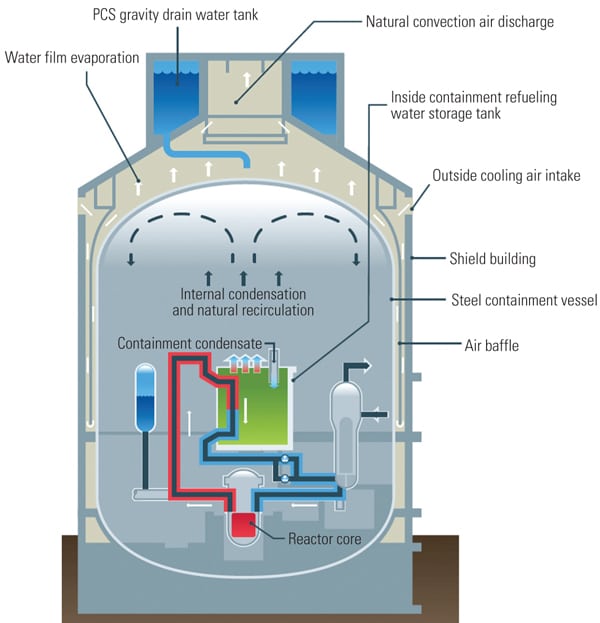 |
| 4. Efficient heat rejection. Transfer of reactor decay heat to the atmosphere is via natural circulation through a passive heat exchanger located on top of the shield building. Courtesy: Westinghouse Electric Co. |
From 72 hours to seven days, makeup water for decay heat removal from the spent fuel pool and containment (the reactor core) is provided by the ancillary water tank located at grade level. Ancillary diesel generators are small (80 kW) and rugged, and they support a few specific plant power needs, such as the makeup pumps used to move water from the ancillary water tank to the spent fuel pool and to the top of the containment vessel.
The ancillary diesel generators also provide power to support main control room displays and lighting as well as selected ventilation systems. In addition, offsite portable diesel generators and diesel-powered pumps from prearranged sources may be brought to the site to provide backup for the ancillary diesel generators and water transfer pumps.
After seven days, the plant continues to function in the same manner, except that additional water supplies are required, either from plant storage tanks, raw water (from, for example, a lake, river, or ocean), or other offsite supplies. The diesel fuel supply for the ancillary diesel engines will also need to be replenished.
The design basis for containment cooling utilizes continuous water distribution on the vessel steel shell. In the highly unlikely case of an operator not being able to supply water to the top of the containment after seven days of cooling, the vessel shell would become dry and the flow of air through the annulus region would provide heat removal. Pressure within the containment vessel would slowly increase but would not reach the normal design pressure for over two days. Even in the case of this very unlikely event, the steel containment vessels have a very large design margin and will not exceed the ASME Service Level C pressure limit. Therefore, even “air-only” cooling decay heat removal for the containment vessel steel shell following seven days of water cooling will prevent damage to the fuel in the reactor core.
Design-Basis Flood. Because the Vogtle site is about 130 miles from the coast and 220 feet above sea level, its location is not vulnerable to floods, tsunamis, dam breaks, or other events on the Savannah River, including the failure of all upstream dams.
Nuclear power plants are designed to effectively manage flooding levels up to the design-basis flood with some degree of margin beyond the design level as part of the plant’s standard design. The maximum flood level assumed for the AP1000 is the plant design grade elevation. Flooding of intake structures, cooling canals, or reservoirs or channel diversions does not prevent safe operation of the plant. In the instance of a design-basis external flood, the AP1000 standard plant response is to stop all unnecessary plant evolutions (such as maintenance or testing) and close external portals. In the unlikely scenario that an AP1000 suffers a severe flood that exceeds the design-basis elevation, the reactor core and spent fuel pool remain protected.
The two most important features of the AP1000 that provide defense against flooding and other external hazards are that safe shutdown and core cooling are provided by systems located inside the containment vessel that are designed to “fail safe” upon loss of power, loss of instrumentation and control, and loss of instrument air. The containment vessel is a 1.75-inch-thick steel pressure vessel that is not affected by flooding. The spent fuel cooling is from water stored in pits that are at least 35 feet above the grade elevation.
High Winds and Tornados. Severe winds, such as those generated by hurricanes or tornados, pose a threat of wind loading on a structure that may cause damage or collapse; damage may also result from tornado missiles that have the potential to penetrate buildings and damage components. The AP1000 protects safety-related SSCs by placing them inside Seismic Category I buildings (the nuclear island) designed to withstand extreme wind loads and tornado-born missiles.
The AP1000 design-basis wind speed for tornados is 300 mph, composed of 240 mph rotational and 60 mph translational. The AP1000 operating basis wind speed is 145 mph, which will not challenge the non-safety-related structures. The tornado missile analysis for the AP1000 nuclear island considers the effects of:
- A 4,000-pound automobile with a horizontal velocity of 105 mph and a vertical velocity of 74 mph. This evaluation bounds sites with vehicles parked within a half-mile radius of the site.
- A 275-pound, 8-inch armor-piercing artillery shell with a horizontal velocity of 105 mph and a vertical velocity of 74 mph.
- A 1-inch-diameter solid steel sphere with a velocity in any direction of 105 mph.
Transportation and Nearby Facility Accidents. The AP1000 has been successfully evaluated against the impacts from a variety of marine accidents, gas/oil pipeline leaks, railroads, industrial and military facilities, and a malevolent large commercial aircraft. The assessment considers damage associated with structural impact, shock-induced vibrations, and fire effects. The assessment concluded that an aircraft impact would not affect the plant’s core cooling capability, containment integrity, or spent fuel pool integrity based on best-estimate assessments established by the NRC. Also, the layout of the nuclear island prevents simultaneous damage of key locations.
Fires. The AP1000 design provides robust protection from postulated fires. This robustness comes from effective separation of redundant features both inside and outside of the containment as well as from the use of passive safety features. The fire protection design provides separation of the alternate safety-related shutdown components and cabling using 3-hour-rated fire barriers. Areas containing safety-related cabling or components are physically separated from one another and from the areas that do not contain any safety-related equipment by 3-hour-rated fire barriers. This design approach reduces the probability of a fire affecting more than one safety-related shutdown system.
Because the passive safety-related systems do not require AC power and other plant services such as cooling, they are less susceptible to a fire than earlier designed plants. The impact of fires on the safe shutdown capability is significantly reduced.
Learning from Others
The first Westinghouse AP1000 nuclear reactors are currently under construction in Sanmen, in China’s Zhejian Province, and are about two years ahead of the Plant Vogtle project. Two more units are under construction at Haiyang in Shandong Province. These lead units give Southern Nuclear an unprecedented opportunity to experience the start-up, operation, and even refueling of the AP1000, thanks to a learning exchange agreement between Southern Nuclear and Shandong Nuclear Power Co. As with Plant Vogtle Units 3 and 4, Shaw is providing engineering, procurement, commissioning, information management, and project management services for these projects.
— James M. Hylko (jhylko1@msn.com) is a POWER contributing editor.


